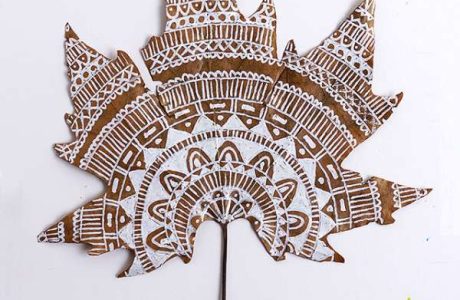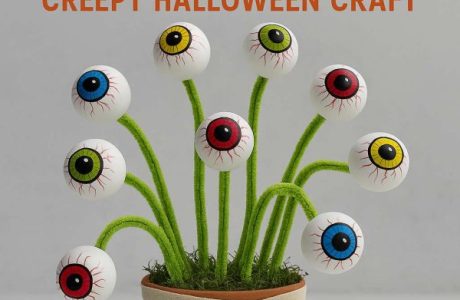
Lampshades come in a wide range of styles, sizes, shapes, and materials, offering a variety of options to suit different tastes and needs. The most common materials used for lampshades are fabric, paper, and metal. Fabric shades can be made from a variety of fabrics such as silk, linen, cotton, and others, and can come in a variety of colors and patterns.
Paper shades are typically made from rice paper, and are often used in Asian-inspired designs. Metal shades are usually made from brass, steel, or aluminum, and are often used in more industrial or modern design schemes. Additionally, lampshades can be made from felt or painted surfaces, giving you even more options for customization and creativity.
Whether you’re looking for a standard lampshade or a unique, one-of-a-kind piece, there’s likely a lampshade material and style that will fit your needs and with these DIY ideas, you are sure to find one that matches your own personal style.
Here is a fun paper cocktail umbrella lampshade, perfect for theme nights and tropical decors
To make a lampshade from scratch, the process may vary based on the type of material you choose to use. For a metal lampshade, it is as simple as installing the bulb and hanging it up [DIY Pendant shades]. For a fabric lampshade, the steps involve fixing the fabric rectangle to the plastic lampshade panel, trimming and attaching it to the metal hoops, binding the edges using double-sided tape, and securing the fabric to the bottom using hot glue [How to make a DIY Lampshade, Fabric Covered Lampshade].
DIY paper lampshades can be made by a decoupage project using cut black paper and favorite shapes [Modpodge Rocks Blog]. DIY felt lampshades can be made by cutting out a felt shape and gluing on other felt pieces to create the desired design [Felt Lampshade by Pillarbox Blue].
Lampshades can also be painted using fabric paint or by misting the color with a spray bottle and using gravity to direct the color flow [Lampshade tutorials, How To Paint A Lampshade].
There are numerous DIY lampshade ideas to get inspired from, including bird lampshades, doily lampshades, paint stick lampshades, and more [20 DIY Lampshade Ideas]. You can even make a lampshade from scratch using wire coat hangers by untwisting and straightening them and then determining the bottom diameter of the lampshade [How To make a lampshade from scratch].
There are many different ways to make a lampshade, each with its own set of steps and techniques to follow. With a little creativity and patience, you can easily create your own personalized lampshade.
Top tips for cleaning a lampshade
If you have an old lampshade that needs cleaning before you DIY it, here are my top tips for cleaning a lampshade.
Cleaning a fabric lampshade can be a delicate task, as the material is susceptible to damage from harsh chemicals and abrasive materials. However, with the right tools and techniques, you can easily restore your lampshade to its original beauty. Here are the steps you need to follow to clean a fabric lampshade:
Dust the Lampshade Regularly: Dust buildup can cause discoloration and damage to the fabric over time. To prevent this, dust the lampshade regularly using a soft brush, such as a feather duster or an old paintbrush. This will also remove any cobwebs or spider webs that may have accumulated.
Vacuum the Lampshade: For a deeper clean, you can use a vacuum cleaner to remove dirt and dust from the fabric. Use the soft brush attachment and be gentle as you work around the lampshade, making sure not to apply too much pressure.
Spot Clean Stains: If your lampshade has any noticeable stains, spot clean them before moving on to a full cleaning. Use a mixture of warm water and a mild soap, such as dish soap, to gently clean the stain. Apply the solution to a soft cloth and dab at the stain, being careful not to rub it. Repeat the process until the stain is removed.
Clean the Lampshade: Fill a basin with warm water and a mild soap, such as dish soap. Dip a soft cloth into the solution and wring out the excess water. Gently wipe the lampshade with the cloth, making sure to cover all areas. Avoid using too much water and be careful not to saturate the fabric.
Dry the Lampshade: After cleaning, use a clean, dry cloth to gently wipe away any excess moisture from the lampshade. Leave the lampshade to air dry in a well-ventilated area, away from direct sunlight or heat sources. Do not use a hair dryer or other heat source to speed up the drying process, as this can cause the fabric to shrink or discolor.
By following these steps, you can keep your fabric lampshade looking clean and beautiful for years to come. Remember to always be gentle when cleaning and to use a mild soap and water solution to avoid damaging the fabric. With a little care and attention, your lampshade will continue to provide a warm and inviting glow to any room in your home.




